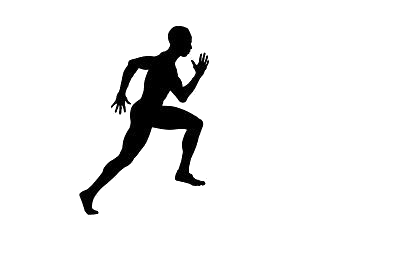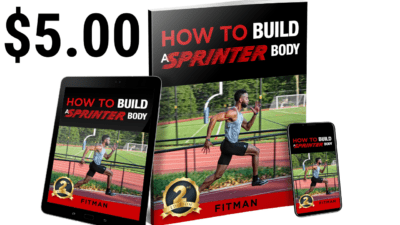Speed kills.
Every athlete in sports that involve sprinting want to know how to sprint faster, but nobody is actually train for pure speed.
The main problem is that most athletes are following programs on and off the track that will not increase their top-end, linear speed.
After using these ill-fated programs they end up inheriting the speed of a sloth due to the abysmal nature of the training, nutrition, and recovery.
Most “speed” training is completely misguided. Training for pure speed is not high-volume running, bodybuilding, speed ladder drills, or powerlifting.
Training for speed puts the top priority on speed.
In this new series we are going to examine the top 5 ways to increase your sprinting speed.
By applying these tips to your training program, you will be able to see real PR’s when you hit the track.
The second way you can sprint faster is:
How To Sprint Faster Through True Speed Training
If you want to get better at something, then you consistently have to do that thing.
It is a flat-out joke in the sprint game when athletes spend far too much time doing everything except sprinting.
Lifting is great and should be a part of a sprinter’s program. But just because you are a beast in the gym does not mean you will dominate on the track.
I moved a 669.5lb barbell hip thrust at the end of 2015 while weighing about 165lbs.
When I showed up for the first outdoor track meet in June 2016 at age 32, my opening 100 meter dash time was a horrendous 12.64 after opening at 11.91 in 2015.
Even though I had glutes that were stronger than vibranium at this point, I was not performing pure speed training at this time. The end result was a lousy time in the 100 meters.
The only way to sprint faster is to get your body used to moving faster and that requires you to consistently sprint at over 90 percent of your maximum.
Weight room strength is not the biggest part of the puzzle.
I’ve known coaches and athletes who talk about building speed, but then they run workouts like 10 x 100m at 60-70 percent of their maximum speed. This formula does not equate to developing high level speed.
Would a powerlifter train to build maximal strength by working with light weights?
No, you would work your main movements in rep ranges of 1-3 and the weight would be relatively heavy.
Sprinters and powerlifters are brothers from different mothers. The principles in the training systems are very similar with the emphasis being on high intensity work with full recoveries.
Sprinters come from Mother Speed and powerlifters come from Mother Strength, but they both have the same daddy named Father CNS.
The 2 guidelines for maximum speed training are:
1) Perform your sprints at over 90 percent of your maximum speed
You will gain nothing speed wise if you do not get after it when you hit the track.
Sprinting is the most explosive movement in the fitness game. You need to perform your reps with a focused intensity.
Getting out to the track and moving like a sloth will have you going nowhere fast. After you perform a proper sprinter warm-up, it is time to go hard.
You are not going to jog. And you are not going to run at 70 percent as all of the action that creates speed will happen at 90 percent.
If you are truly training for speed development you will need a coach to time you or you will need electronic timing like the Freelap Timing System in order to track your times yourself.
A stopwatch will also work but you just have to get used to timing yourself. If you are training just to add sprinting to your lifting workouts then that 90 percent will be measured in effort instead of a recorded time.
A sample true speed workout that focused on acceleration and maximum velocity would look like this:
• 3 sets (3×1) of 30 meter sprints from a standing or ground start (3 or 4 point start)
• 3 sets (3×1) of flying 30 meter sprints with a 30 meter run-in
• If you are a beginner rest 3-5 minutes between sets
• If you are advanced, rest about 5-8 minutes between sets
The goal of each repetition is quality.
2) Take adequate rest between reps
Traditional high-intensity conditioning training like The Punisher Workout are well-known for being hard to do because of the lack of rest.
Anytime you reduce the rest periods in training you will increase the difficulty but there is a caveat; you will sacrifice your top-end performance in terms of top-end speed or strength. Let me explain.
In the sprint game if you are training to get faster, you cannot expect to run a hard 60 meter sprint and then rest only 15 seconds before doing set 2.
Because your recovery was so short, your speed will take a precipitous drop.
Once you lose speed, you are no longer training for pure speed and your workout becomes another conditioning workout.
A good rule of thumb in sprinting is to rest 1 minute for every 10 meters you sprint. For example a max effort, 60 meter sprint would require a 6 minute rest.
There is a time and place for shorter rest periods but not when the goal is maximum speed.
As I applied all these methods to my training in 2016 and 2017 I was able to hit 11.57 in the 100m and 23.78 in the 200m at age 33.
Sprinting is a young athlete’s game but proper training can allow you to still have speed as you get older.
I was faster at age 33 than I was at ages 31 and 32 but there is no magic in why. By applying these methods to your training program, you will also get faster.
It also feels great to cross the finish line before men (mostly high school and college athletes) who are ages 18-30 years old and who are closer to their prime than I.
The elite guys at these meets still smoke me though!
Bonus: How To Get Faster By Reading Use Speed To Get Lean
You can learn about my new eBook, Use Speed To Get Lean by watching the video below. This is the first book in the fitness game to combine the power of sprinting and lifting.
Today we have learned information that can be used immediately to improve your performance.
But what if I told you there are more things you can implement to sprint faster?
Stay tuned for part III of this series.
I’ll holla at you next time.
The People’s Trainer,
Fitman


